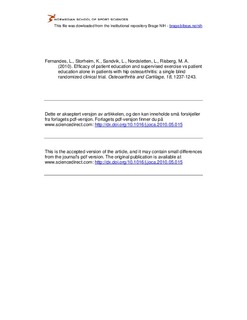| dc.description.abstract | Objective: To compare the efficacy of patient education and supervised exercise with that of patient education alone for the management of pain in patients with hip osteoarthritis (OA).
Design: Single blind randomized clinical trial. Setting: Recruitment of patients from hospitals, primary health care and advertisement, Oslo, Norway. Participants:
109 patients with radiographic and symptomatic hip OA with mild to moderate symptoms. Interventions: Patient education (PE). Patient education and supervised exercise (PE + SE).
Primary outcome measure: The pain subscale of the Western Ontario and McMaster Universities Osteoarthritis Index (WOMAC pain).
Results: No significant between group differences were found for WOMAC pain over the 16-month follow-up. Significant improvements were found for the secondary outcome WOMAC physical function (P = 0.011) in the group receiving PE + SE compared to the group receiving PE only. No significant differences were found for WOMAC stiffness, the SF-36 subscales or the activity scale. The effect sizes (95% confidence interval) for WOMAC pain were −0.26 (0.11, −0.64), −0.35 (0.07, −0.77), and −0.30 (0.15, −0.75), and for WOMAC physical function −0.29 (0.09, −0.67), −0.48 (−0.06, −0.91), and −0.47 (−0.02, −0.93) at 4, 10 and 16 months, respectively, in favor of the group receiving both PE and SE. All patients attended the three-session PE program, and 75% performed ≥16 sessions of the 12-week SE program.
Conclusion: The study could not demonstrate a significant difference in pain reduction over time between PE + SE vs PE alone. Adding SE to PE may improve physical function, but the magnitude of possible benefit is unknown as the 95% confidence intervals around the mean difference were wide. | en_US |
